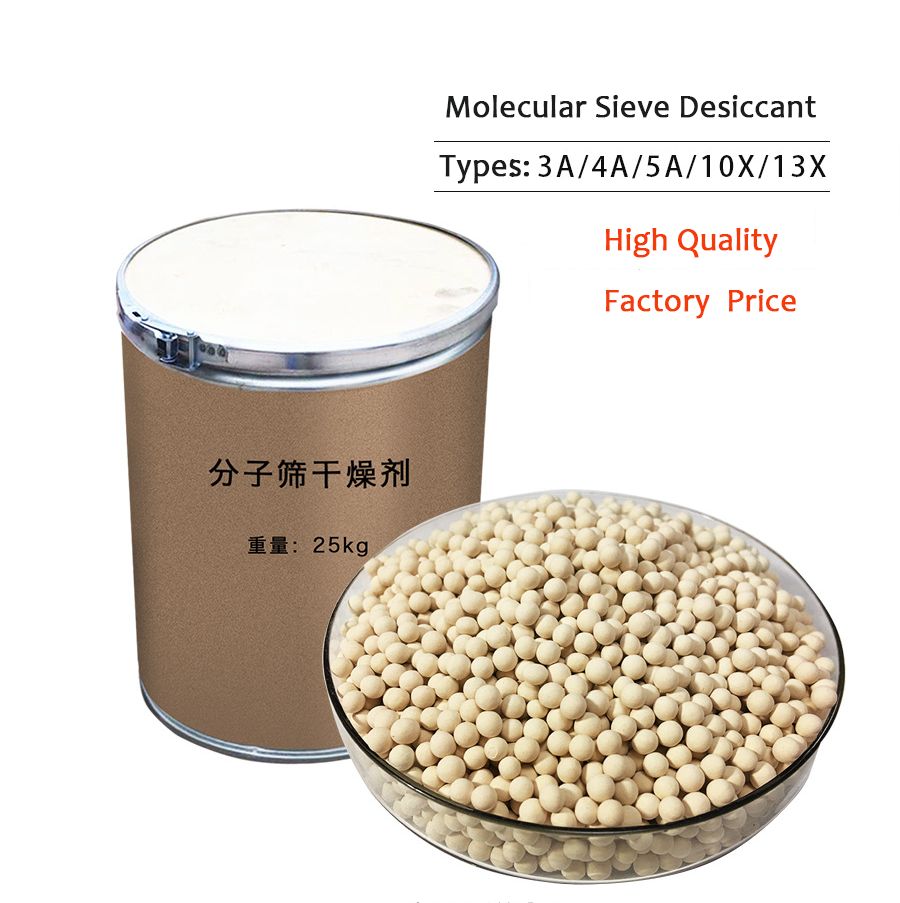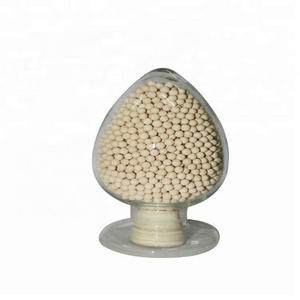making it very selective. This type of bead also has advantages in crush strength, durability and high rate of adsorption. The 3A molecular sieve can remove moisture in both liquid and gas applications. Type 3A is used in the production of insulated glass, refrigerant drying, general moisture removal and the drying of natural gas, hydrocarbon liquids, ethanol and reactive monomers such as olefins.
- Product Details
- {{item.text}}
Quick Details
-
MF:
-
AlCaNaO9Si3
-
EINECS No.:
-
N/A
-
Place of Origin:
-
China
-
Brand Name:
-
Zhongchuang
-
Model Number:
-
ZC-MS112210
-
Bulk density(g/ml):
-
≥0.62
-
H2O capacity(%):
-
≥25
-
Model Number::
-
13x molecular sieve
-
Adsorbent Variety::
-
Molecular Sieve
-
Bulk density (g/cm3)::
-
≥0.63
-
Particle size of the qualified(%)::
-
≥99.00
-
Static CO2 adsorption::
-
≥18
Quick Details
-
CAS No.:
-
63231-69-6
-
Purity:
-
99%min, 99.9%
-
Other Names:
-
zeolite
-
MF:
-
AlCaNaO9Si3
-
EINECS No.:
-
N/A
-
Place of Origin:
-
China
-
Brand Name:
-
Zhongchuang
-
Model Number:
-
ZC-MS112210
-
Bulk density(g/ml):
-
≥0.62
-
H2O capacity(%):
-
≥25
-
Model Number::
-
13x molecular sieve
-
Adsorbent Variety::
-
Molecular Sieve
-
Bulk density (g/cm3)::
-
≥0.63
-
Particle size of the qualified(%)::
-
≥99.00
-
Static CO2 adsorption::
-
≥18
Product Description
Molecular sieve adsorbents are crystalline aluminosilicates, known as zeolites. Their unique structure allows the water of crystallization to be removed, leaving a porous crystalline structure. These pores, or cages, have a high affinity to re-adsorb water or other polar molecules. Aided by strong ionic forces (electrostatic fields) due to the presence of cations such as sodium, calcium and potassium, and by the enormous internal surface area of up to 1,000 m2/g, molecular sieves will adsorb a considerable amount of water or other fluids. If the fluid to be adsorbed is a polar compound, it can be adsorbed with high loading, even at very low concentrations of the fluid. Molecular sieves will, therefore, remove gas or liquid impurities to very low levels (ppm or less).
Another feature of molecular sieve adsorbents is their ability to separate gases or liquids by molecular size or polarity. The pore, or cage, openings are the same size as many molecules, e.g., in the case of hydrocarbon paraffins, straight-chained molecules can fit into the pores and be adsorbed, while the branched-chain molecules cannot enter the pores and pass through the molecular sieve bed unadsorbed.
|
U13X Molecular Sieve
|
unit
|
sphere
|
|
pallet/cylindrical
|
|
||
|
Diameter
|
mesh
|
8X12
|
4-12
|
8X12
|
1/8
|
||
|
water adsorption capacity
|
>%wt
|
26
|
26
|
26
|
26
|
||
|
Co2 ADSORPTION CAPACITY
|
<mg/g
|
180
|
180
|
180
|
180
|
||
|
bulk density
|
>g/ml
|
0.65
|
0.64
|
0.62
|
0.61
|
||
|
strength
|
>N
|
30
|
70
|
30
|
70
|
||
|
Abrasion
|
<%et
|
0.1
|
0.1
|
0.2
|
0.2
|
||
|
water content
|
<%wt
|
1.5
|
1.5
|
1.5
|
1.5
|
||




Molecular Sieve Series
3A Molecular Sieve
The 3A molecular sieve is an alkali metal aluminosilicate with a pore opening of approximately 3 angstroms. Type 3A is made by ion-exchanging the sodium in the type 4A sieve with potassium. The 3A molecular sieve will exclude most molecules except water,
making it very selective. This type of bead also has advantages in crush strength, durability and high rate of adsorption. The 3A molecular sieve can remove moisture in both liquid and gas applications. Type 3A is used in the production of insulated glass, refrigerant drying, general moisture removal and the drying of natural gas, hydrocarbon liquids, ethanol and reactive monomers such as olefins.
making it very selective. This type of bead also has advantages in crush strength, durability and high rate of adsorption. The 3A molecular sieve can remove moisture in both liquid and gas applications. Type 3A is used in the production of insulated glass, refrigerant drying, general moisture removal and the drying of natural gas, hydrocarbon liquids, ethanol and reactive monomers such as olefins.
4A Molecular Sieve
The 4A molecular sieve is an alkali metal aluminosilicate with an effective pore opening of approximately 4 angstroms.
The sodium form of type A is widely used as a general-purpose drying agent and has good physical and adsorption properties.
Type 4A beads can be used to adsorb water, ammonia, methanol, ethanol and carbon dioxide. This type of molecular sieve is often used to remove moisture from gas and liquid streams, where co-adsorption of sulfur compounds and carbon dioxide is not a concern.
5A Molecular Sieve
The 5A molecular sieve is an alkali metal aluminosilicate with an effective pore opening of 5 angstroms and is the calcium-exchanged form of the type A zeolite. The strong ionic forces of the divalent calcium cation make 5A an excellent choice for removing carbon dioxide, carbon monoxide, alcohols and other oxygenates, hydrogen sulfide, methyl and ethyl mercaptans, and other polar molecules. This product is also effective for the bulk separation of normal and iso-paraffin hydrocarbons. This type of molecular sieve has a high rate of adsorption and desorption, a higher rate of contamination resistance and a high crush strength.
13X Molecular Sieve
The 13X molecular sieve is the sodium form of zeolite X and has a much larger pore opening than the type A crystals, with an effective pore diameter of 10 angstroms. It also has the highest theoretical capacity of the common adsorbents and excellent mass transfer rates. Type 13X offers enhanced adsorption performance over the type A zeolite, and it can remove impurities too large to fit into the type A zeolite crystal cages. It is also often used to separate nitrogen from the air to produce a high-purity oxygen stream. Our 13X materials are physically robust and have high adsorption capacity for water, alcohols and other oxygenates, sulfur
compounds and carbon dioxide.
compounds and carbon dioxide.
Application
Natural Gas Processing
Natural Gas Processing
Natural Gas Processing
Dehydration of natural gas and natural gas liquids such as propane and butane
Removal of CO2 , H2 S, mercaptans and other impurities from natural gas or natural gas liquids
Hydrogen Production or Recovery
Hydrogen Production or Recovery
Drying and purification of H2 using either thermal swing or pressure swing adsorption
Industrial Gases
Dehydration and CO2 removal from air for cryogenic processing
Separation of high-purity oxygen from air via Pressure Swing Adsorption (PSA) or Vacuum Swing Adsorption (VSA)
Recovery of inert gases by adsorption
Petroleum Refining
Dehydration of light-ends (e.g. olefin) for cryogenic recovery
Purification of feed to catalytic processes such as isomerization, dimerization and alkylation units
Chemical Storage
Underground cavern drying and treating
Storage tank breathers
Product recovery from vent streams
Fuel Ethanol Production
Bulk water removal at the azeotrope
Purification of food- and pharmaceutical-grade ethanol
Basic Petrochemical and Synthesis Gas Processes
Purification of natural gas feed
Drying and purification of the reformer gas prior to the ammonia loop
Treating of ammonia off-gas streams
Olefin and polyolefin production
Drying of cracked olefin gas, ethylene and propylene products
Dehydration and purification of ethane feed to the cracker
Impurity removal from polyolefin plant feed (catalyst protection from oxygenates, sulfides
Miscellaneous Petrochemicals
Drying of solvents
Purification of feed streams to catalytic processes such as for ethyl benzene
Industrial Applications
Insulating Glass
Prevention of condensation in the insulating glass space of windows
Pollution and VOC Control
Containment and concentration of solvent vapors
Medical Uses
Oxygen concentrators for respiratory therapy
Package Protection
Dehydration and trace contamination removal in enclosed spaces
Removal of odors
Polymer Processing
Removal of water of reaction in urethane formulations
Cell size control in blown foams
Plastic pellet driers prior to blowor injection-molding
Systems Protection Devices
Dehydration and filtration of refrigerant loops
Dehydration and purification of compressed breathing air
Dehydration of compressed air for pneumatic tools
Truck and railroad air brake drier
Product packaging
Hot Searches













